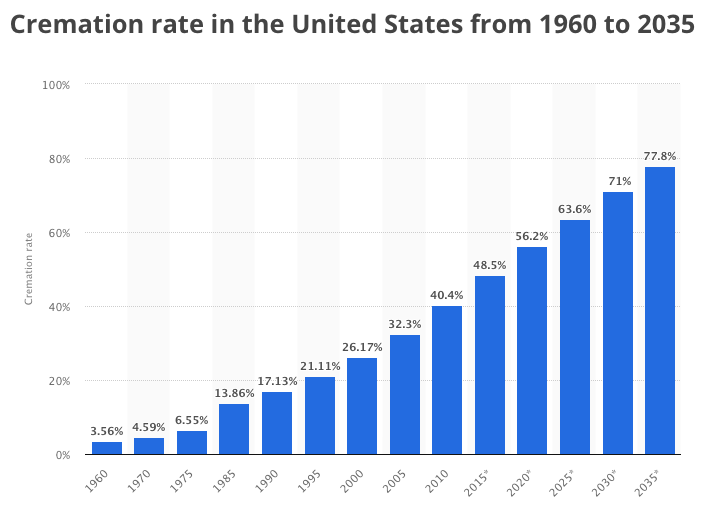Do Death Care consumers trade down in a weak economic environment?

Has the death care community ever studied if, when faced with economic difficulties, the purchase of death care such as funerals, caskets, cremations, and other services reflect those economic times or do the vast majority of death care consumers select the disposition option, such as burial and cremation, that is most meaningful to them regardless of where there personal finances are at the time? I have some thoughts on that question and will try to give my answer in this short column.
We certainly are living in some interesting times when it comes to consumerism, inflation, and spending. Over the Memorial Day weekend we have had “experts” opine with such differences that one almost has to take an “expert’s line of thinking with a grain of salt. None of them have a crystal ball, but over the weekend I heard differing opinions that America’s economic future is teetering on a recessionary movement, to an opinion that the federal funds rate will be increased once again to cut the economy back from its present “too good” status and fight inflation, to a comment by one analyst that he believes that “Artificial Intelligence” will soon signal the beginning of the 4th Industrial Revolution (the other three being the invention of the steam engine, the age of science and mass production, and the rise of digital technology) that will usher in an age of increased prosperity for the developed world.
Those are three opinions and all are possible but for the sake of this article, “What does happen to death care sales if the economy slips into a recession”? Can death care learn from the general retailers or are we different because of the fact that our purchasers are “one-time preference” purchasers? I don’t know if we know that answer.
Here’s a recent article from Yahoo Finance entitled, “WalMart, Target earnings show signs of consumers trading down?” Here’s the first line of that article — “Americans are getting more cautious about their spending, and signs are emerging that they may be trading down to cheaper options, according to quarterly earnings reports from the biggest names in US retail.”

Tom Anderson
Funeral Director Daily
If you go on to read that article you will find the general nature of it is that WalMart is growing in sales and Target is declining as the basic inflation rate stays above the long-term United States average which is 3.28%.
What about death care and funeral purchases? Do consumers trade down in an inflationary environment? I looked and found this graph about the growth of cremation in the United States. It is difficult to ascertain, and especially because cremation has now become a “personal choice” preference, but the last time America found ourselves in an inflationary environment such as we are in today, the use of cremation more than doubled from 1975 to 1985. In those years the United States cremation rate moved from 6.55% to 13.86%. It has not done that – doubled- in any other ten-year period, before or since. And, inflation in that 10-year period had three years in which inflation topped 10%, beginning with an 11.8% rate in 1975. It first showed signs of taming with a 3.71% inflation rate in 1983.

We don’t know, but one has to wonder what was the reason for the doubling of cremation in that ten-year period? Was it simply because cremation was becoming a more acceptable form of disposition or was it seen as a “low-cost alternative to the funeral” in a time when inflation had wreaked havoc on America’s consumers? Or was it a combination of those reasons?
I don’t know if we will ever know the answer but the thought may bring a cautious bent to the forward look of today’s funeral homes. If the American consumer has indeed lost purchasing power to inflation will that manifest itself on death care choices? And, if so, what choices?
Since we are a plurality cremation society today, if the death care consumer “trades down” what does that mean? Does it mean forgoing an urn. . . does it mean forgoing a memorial or celebration service. . . .does it mean going without a columbarium or cremation niche. . . .or does it even mean moving to cremation for someone thinking about an earth burial?
Today is again one of those articles with no answers but lots of questions – an article placed simply to make us think and strategize with what we theorize may happen. Already operating in an environment when overall deaths have dropped due to the end of the pandemic and at the same time being in an environment where many costs are driven higher by inflation, funeral home, crematory, and cemetery operators don’t want to get caught in an environment where consumers are also “trading down” on their selections causing a drop in revenue. It’s good to give a little thought on how your funeral home can avoid that situation, if possible.
Those reasons also give rise to why it is important to advocate and give resources to the process of Preneed which would let consumers make a decision years ahead of time, probably in a more certain financial period for them.
It’s just good to be aware of what is happening and, as for me, I’m hopeful that the analyst who called the Artificial Intelligence craze the potential beginning of the 4th Industrial Revolution is correct and that will create an economic engine that will bring more prosperity to all. . . . and allow for consumers to “trade up” rather than “trade down”.
Related— Here’s something from Wikipedia describing the three industrial revolutions and explaining what the 4th may look like.
More news from the world of Death Care:
- Interest in green burials, actual purchases lagging in Western New York. Spectrum 1 News
- Inside Pele’s tomb in world’s tallest cemetery where fans can pay respects to icon who was laid to rest in gold coffin. The U.S. Sun
- Town approves cntract for “neglected cemetery’ cleanup. The New Caananite (CT)
- Water cremation for pets. ABS-CBN News (Singapore)
Enter your e-mail below to join the 3,256 others who receive Funeral Director Daily articles daily:




















